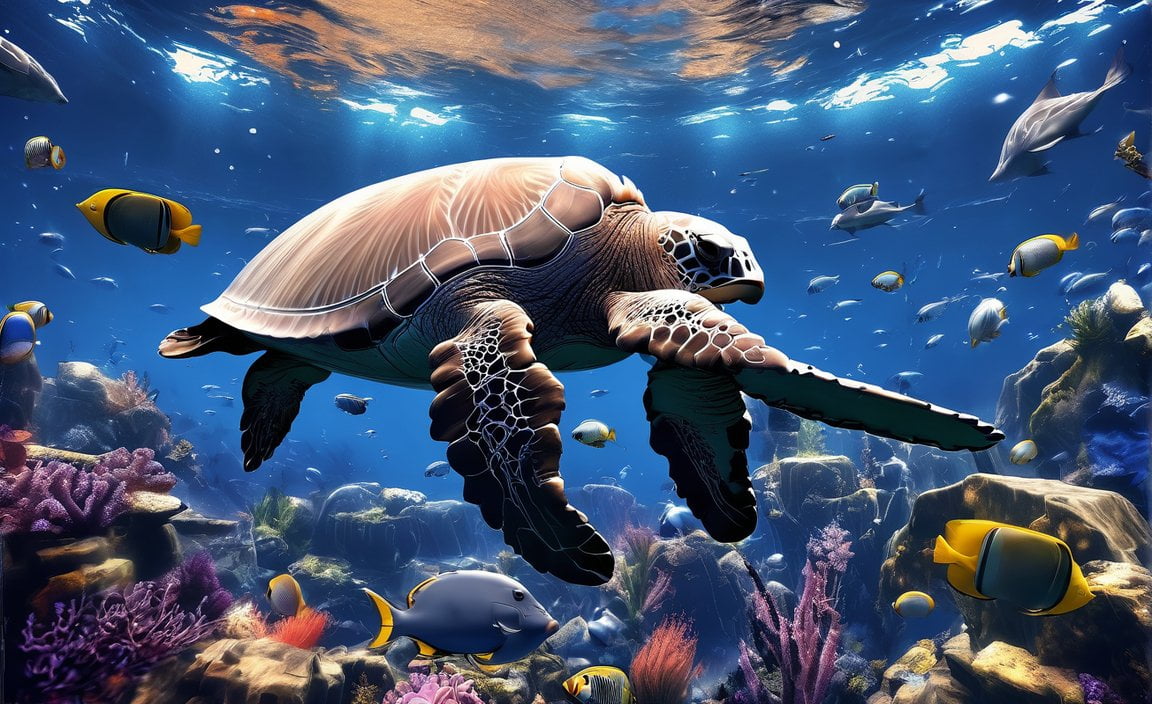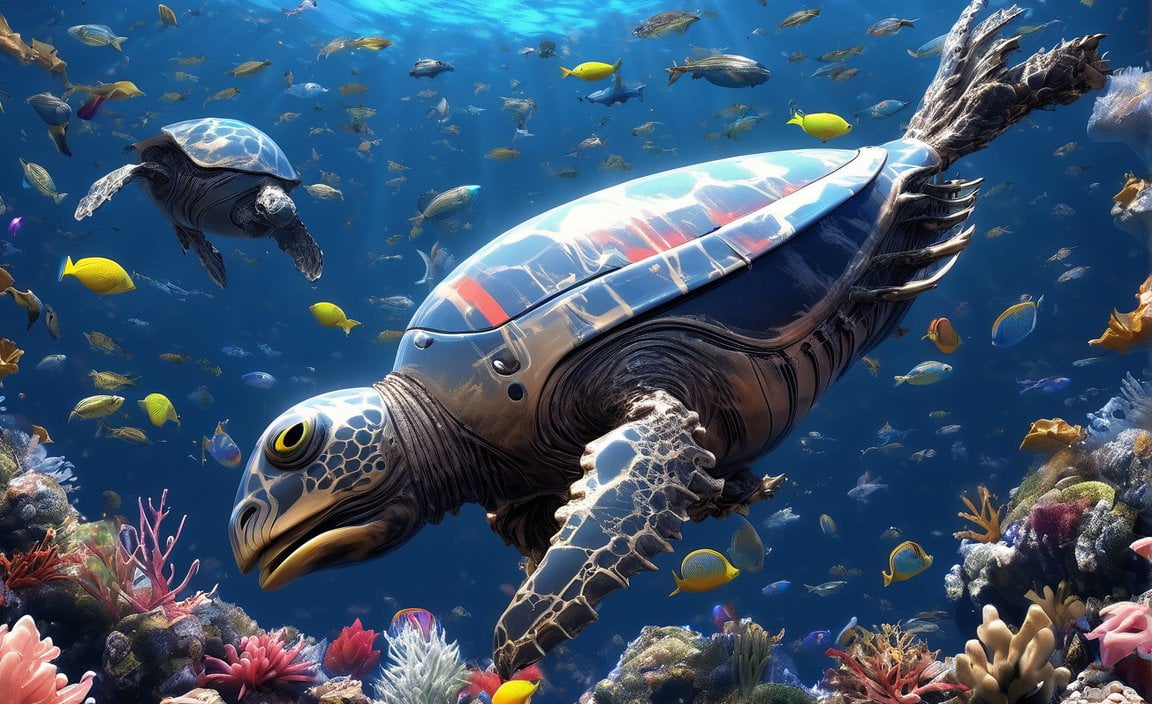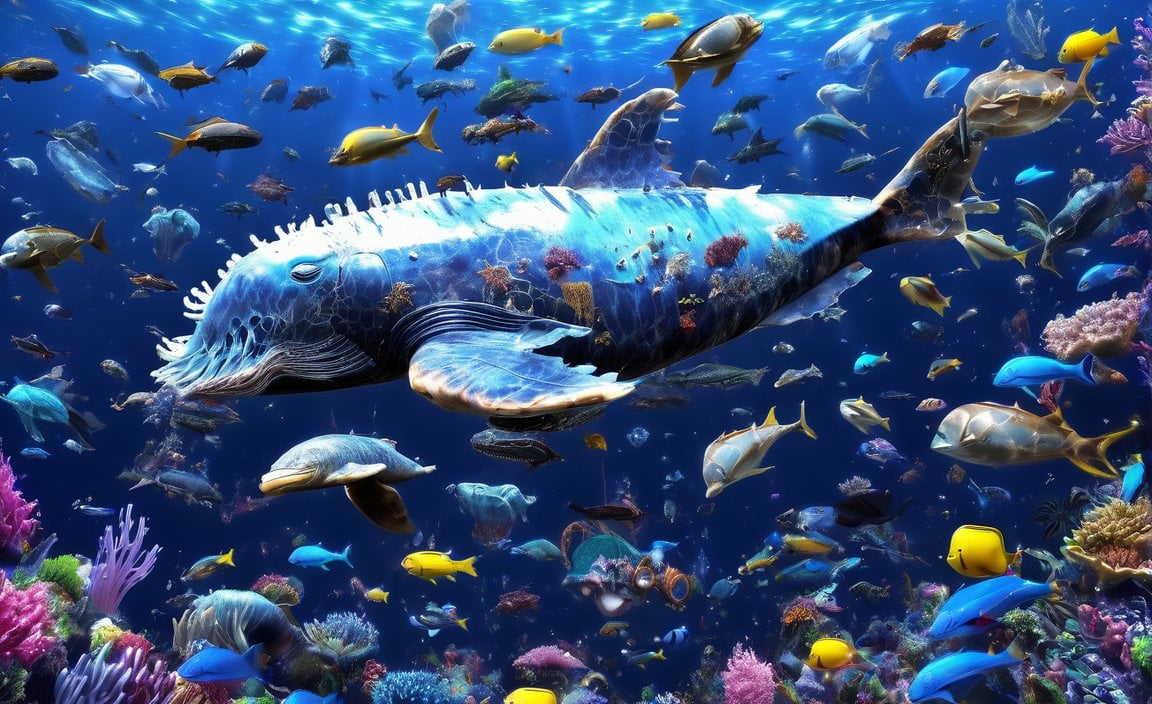Discover the mesmerizing world of marine animals with “Exploring Fascinating Marine Animals: 5 Intriguing Facts.” Delve into the depths of our oceans as we uncover five captivating insights about these captivating creatures. From the mesmerizing behavior of dolphins to the incredible adaptability of octopuses, this article will take you on a journey of discovery and appreciation for the wonders of marine life.

Key Takeaways:
– Jellyfish have been around for over 650 million years, predating dinosaurs and sharks.
– Electric Eels can generate enough electricity to light up to 10 electric bulbs.
– Dolphins sleep with only half of their brain and one eye open to watch for predators and threats.
– The first animals traced back 40 million years ago were Ediacara biota, which were small in size.
– Coral reefs house one-fourth of the world’s marine species.
– Male sea horses are capable of getting pregnant and giving birth.
– Stonefish are highly dangerous sea animals due to their venomous spines.
5 Facts About Marine Animals
Did you know that the world beneath the ocean’s surface holds a treasure trove of fascinating facts about marine animals? From ancient creatures to surprising abilities, these animals continue to amaze marine biologists and conservationists alike. In this article, we will explore 5 intriguing facts about marine animals that will leave you in awe.
1. Jellyfish: Ancient Survivors
Imagine if I told you that jellyfish have been around for more than 650 million years, predating dinosaurs and even sharks? It’s true! These ethereal creatures have a remarkable history, outlasting many of the Earth’s most iconic species. Next time you encounter a jellyfish, remember that you are witnessing a living relic from a bygone era.
2. Electric Eels: Shocking Powerhouses
Prepare to be electrified by this fact! Electric eels, often found in the freshwater rivers of South America, possess an astonishing ability. They can produce enough electricity to light up to 10 electric bulbs. Their unique superpower allows them not only to navigate their surroundings but also to immobilize prey or deter potential threats. Talk about a shocking defense mechanism!
3. Dolphins: Sleep Deprived Guardians
When it comes to multitasking, dolphins are the masters. These intelligent creatures have devised a unique sleeping pattern to ensure their safety in the vast ocean. While they do need rest like any other living being, dolphins sleep with only half of their brain and one eye open. This allows them to stay vigilant, keeping an eye out for predators or any potential dangers that may lurk nearby. It’s like they never take a true nap!
4. Ediacara Biota: Ancient Enigmas
Before today’s diverse marine species evolved, the world’s ancient oceans were home to fascinating organisms known as Ediacara biota. These unique creatures, dating back 40 million years ago, were only a few centimeters in length. While they may have been small in size, their significance in the history of marine life cannot be overstated. Studying these enigmas provides invaluable insights into the evolution of our oceans.
5. Coral Reefs: Biodiversity Hotspots
Coral reefs are renowned for their sensational beauty, but did you know that they are home to one-fourth of the world’s marine species? These vibrant ecosystems provide shelter, food, and breeding grounds for a remarkable array of creatures. Take a moment to appreciate the intricate balance of life within a coral reef, where countless species coexist in harmony.
Now that you’ve uncovered these 5 fascinating facts about marine animals, the wonders of our oceans have become even more captivating. From ancient survivors to shocking powerhouses, these creatures continue to astound us with their unique qualities. Let’s always strive to protect and conserve their habitats, ensuring that future generations can appreciate the awe-inspiring treasures of the deep blue sea.
References:
[1] Amazing Facts about Marine Animals
[2] 10 Facts about Marine Animals
Here are some fascinating facts for you:
5 facts about animal welfare: Did you know that animal welfare plays a crucial role in our society? Discover five intriguing facts about how we can ensure the well-being of our furry friends.
5 facts about common snapping turtle: Get ready to be amazed by the wonders of nature! Explore five captivating facts about the common snapping turtle and unravel the mysteries of this remarkable creature.
5 facts about Indus Valley civilization: Step back in time and dive into the history of the Indus Valley civilization. Uncover five intriguing facts about this ancient culture that will leave you in awe.
5 facts about lakes and ponds: Did you know that lakes and ponds are teeming with secrets beneath their tranquil surfaces? Dive into the depths to discover five fascinating facts about these aquatic wonders.
Feel free to explore these links and expand your knowledge on these captivating topics!
Marine Animals Engage in Complex Social Behaviors and Communication
Key Takeaways:
– Communication in marine animals can be both vocal and non-vocal, serving various functions such as social recognition, finding mates, and engaging in territorial disputes (ResearchGate, Wikipedia).
– Like humans, marine mammals exhibit complex social behaviors influenced by genes, the environment, and social factors (The Conversation).
– Foraging, mating, and parental strategies play a role in the signaling behavior of marine mammals (ResearchGate).
– Learning and social structure are significant factors in how marine mammal populations respond to change (The Conversation).
– Human activities can impact the social behavior of marine mammals, highlighting the importance of marine conservation (Frontiers).
– New technologies, such as high-resolution acoustic tracking, help scientists gain insights into the social associations of marine animals (Frontiers).
– Whales and dolphins, as marine mammals, showcase remarkable adaptations, complex social behavior, and unique vocalizations (National Geographic).
– The transition from land to water has influenced the intelligence and social complexity of marine mammals (Frontiers).
– Keeping marine mammals in captivity can negatively impact their intelligence and social behavior (Springer).
Marine animals are far more fascinating and sociable than meets the eye. These enchanting creatures engage in complex social behaviors and have developed sophisticated communication systems to interact with one another and navigate their marine habitats. Let’s dive deeper into the captivating world of marine animals and uncover five intriguing facts about their social dynamics and communication.
Marine Mammals: Masters of Vocal and Non-Vocal Communication
From playful dolphins to majestic whales, marine mammals have mastered the art of communication. Just like humans, they employ both vocal and non-vocal signals to convey messages. Vocal communication involves a range of captivating vocalizations, while non-vocal communication is based on sound signals. This diverse range of communication methods allows marine mammals to establish social recognition, aggregate in groups, find mates, and even engage in territorial or mating disputes[^1^].
Social Behaviors Shaped by Genes, Environment, and Social Factors
Ever wondered what determines the intricate social behaviors of marine mammals? It’s a combination of genes, the environment they inhabit, and social factors. Various studies have revealed that social behaviors exhibited by marine mammals, such as dolphins and whales, are partially influenced by genetic predispositions and the social environment they grow up in[^3^]. This means that just like humans, social connections and interactions play a crucial role in shaping their behavior. Interestingly, these social factors can also influence their intelligence and ability to adapt to changing circumstances[^5^].
Signaling Behavior: Keys to Survival
For marine mammals, signaling behavior is intricately linked to crucial survival activities like foraging, mating, and parental strategies. Whether it’s dolphins coordinating hunting efforts or whales communicating to find potential mates, their signaling systems are finely tuned. Researchers have found that marine mammals employ various signals such as vocalizations, body movements, and even intricate displays to convey information related to feeding, mating, and other important behaviors[^4^]. These signals enable them to navigate their environment successfully and ensure the survival of their species.
Learning and Social Structure: Vital in Adapting to Change
Marine mammals rely on a combination of learning and social structure to respond effectively to changing environments. Research has shown that social structure, where individuals have specific roles and responsibilities, greatly influences the behavior of marine mammal populations. The ability to learn and adapt is vital, as it aids in responding to changes in resources, threats, or environmental conditions[^5^]. By studying their social dynamics, scientists gain valuable insights into how marine mammals navigate and thrive in ever-changing ocean ecosystems.
Human Impact on Social Behavior
As custodians of the planet, we bear the responsibility to protect marine animals and their social behaviors. Human activities, such as pollution, climate change, and habitat destruction, can significantly impact the marine environment and disrupt the intricate social networks of marine mammals[^6^]. It is crucial to prioritize marine conservation efforts to preserve the rich social lives of these remarkable creatures and ensure their continued survival.
Harnessing Technology to Understand Social Associations
Advancements in technology are providing scientists with unprecedented tools to study the social associations of marine animals. High-resolution acoustic tracking systems, for example, enable researchers to track and monitor the movements and social interactions of marine mammals. This technology allows scientists to unravel the complex social structure and behavioral patterns within different populations[^7^]. By understanding these social associations, we can gain valuable knowledge for the conservation and management of these incredible marine creatures.
In conclusion, marine animals possess an astonishing array of complex social behaviors and communication skills. Their ability to navigate their marine habitats, form social connections, and convey messages through vocal and non-vocal means is a testament to their intelligence and adaptability. By appreciating and safeguarding the social lives of marine animals, we can contribute to the preservation of the wonders of our oceans and ensure a thriving ecosystem for generations to come.
Sources:
– [^1^] ResearchGate – Communication in Marine Mammals (PDF)
– [^3^] The Conversation – The social life of sea mammals is key to their survival
Exploring Fascinating Marine Animals: 5 Intriguing Facts
Marine animals play crucial roles in maintaining the health of marine ecosystems. These captivating creatures contribute to the balance and biodiversity of our oceans, supporting the overall well-being of the biosphere. Let’s delve into 5 intriguing facts about marine animals that highlight their significance in maintaining marine ecosystems.
Fact 1: Ecological Roles of Marine Animals
From top-level predators to nutrient cycling facilitators, marine animals have diverse ecological roles. They serve as vital components in marine food chains, maintaining the balance of species populations. For instance, marine mammals like killer whales and seals play a crucial role as top-level predators, regulating the abundance of their prey.
Fact 2: Nutrient Cycling and Marine Animals
Marine mammals and seabirds contribute significantly to nutrient cycling in marine ecosystems. Their waste materials, such as feces and carcasses, contain essential nutrients that stimulate primary production. As mobile vectors for nutrient transport, these marine animals play a crucial role in distributing nutrients across vast oceanic regions.
Fact 3: Coastal Ecosystem Services and Marine Predators
Predators, including marine mammals and other marine animals, play a pivotal role in maintaining coastal ecosystem services. By controlling the population dynamics of their prey, they prevent imbalances that could disrupt the health of coastal areas. However, further research is needed to fully understand the prevalence, direction, and strength of their role in these ecosystems.
Fact 4: Conservation of Marine Biodiversity
The conservation of marine biodiversity is of utmost importance, considering its significant contribution to the overall health of the planet. Marine animals are key components of these diverse ecosystems, providing critical ecosystem services and supporting sustainable development. Safeguarding marine life and biodiversity is vital for the survival of countless species and the ecosystems they inhabit.
Fact 5: The Balance of the Biosphere
Marine animals, through their ecological roles, nutrient cycling, and conservation efforts, play an indispensable part in maintaining the balance of the biosphere. Without their contributions, marine ecosystems would face imbalances that could have far-reaching consequences for all living organisms on Earth.
Key Takeaways:
- Marine animals play vital roles in maintaining the health and balance of marine ecosystems.
- They serve as top-level predators, regulate prey populations, and contribute to nutrient cycling.
- Marine mammals and seabirds facilitate nutrient transport and stimulate primary production through their waste materials.
- Predators, including marine animals, help maintain coastal ecosystem services.
- Conservation efforts for marine biodiversity are crucial for the overall well-being of the planet.
Sources:
– National Geographic – Ocean Animals Life Under the Sea
– Marine Conservation Ecology Lab – Ecological roles and importance of marine mammals
Marine Animals Face Various Threats from Human Activities and Climate Change
Marine animals, fascinating creatures that inhabit our oceans, are facing numerous threats from human activities and climate change. These threats have had a significant impact on marine biodiversity and have affected various species. In a recent study published in the journal Science, researchers highlighted the cumulative impact of human life on marine biodiversity and identified the most affected species. The study revealed that over 45,000 marine species are at risk, with climate change, pollution, overfishing, and habitat loss being major contributors to their decline.
Climate change is identified as one of the primary threats to marine species, impacting at least 41% of threatened species. The rising temperatures and extreme weather events associated with climate change are affecting the health and survival of marine animals. While land animals also face challenges from climate change, marine creatures are particularly vulnerable due to their dependence on oceanic ecosystems.
Furthermore, human activities have led to habitat destruction and pollution, exacerbating the threats faced by marine animals. Overfishing has caused a decline in fish stocks, with one-third of fish stocks being over-exploited. This not only affects marine species but also disrupts the balance of coastal ecosystems.
The University of Queensland researchers, in collaboration with global marine experts, have developed a framework to categorize and assess the vulnerability of marine species. Their work has identified over 1,550 marine animals and plants that are currently at risk of extinction due to human activity and climate change.
According to the International Union for Conservation of Nature (IUCN), human activity is decimating marine species, leading to a “perfect storm” of threats to marine life. Urgent conservation and mitigation efforts are needed to protect marine biodiversity and prevent further species loss.
Key Takeaways:
- Human activity has had a significant impact on marine biodiversity and has affected various marine species.
- A new study highlights the cumulative impact of human life on marine biodiversity and identifies the most affected species.
- Climate change, pollution, overfishing, and habitat loss are major contributors to the decline of marine species.
- Over 45,000 marine species are at risk, with climate change impacting at least 41% of threatened species.
- Over 1,550 marine animals and plants are currently at risk of extinction due to human activity and climate change.
- Urgent conservation and mitigation efforts are necessary to protect marine biodiversity and prevent further loss of species.
Sources:
1. World Economic Forum
2. Nature

FAQ
Q1: How long have jellyfish been around?
A1: Jellyfish have been around for more than 650 million years, predating dinosaurs and sharks.
Q2: How much electricity can electric eels produce?
A2: Electric eels can produce enough electricity to light up to 10 electric bulbs.
Q3: How do dolphins sleep?
A3: Dolphins sleep with only half of their brain and one eye open to watch for predators and threats.
Q4: When were the first animals traced back?
A4: The first animals traced back 40 million years ago were Ediacara biota, which were only a few centimeters in length.
Q5: How much marine species do coral reefs contain?
A5: Coral reefs contain one-fourth of the world’s marine species.
















